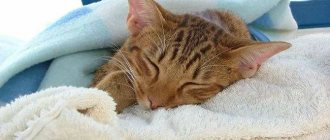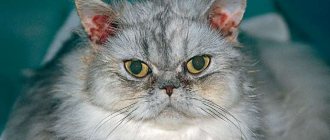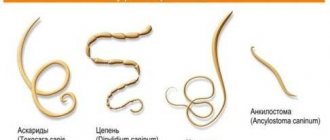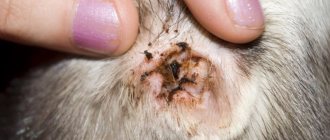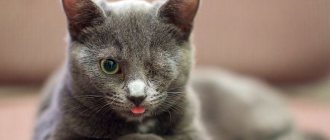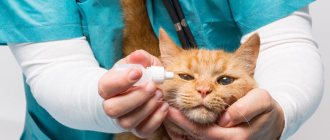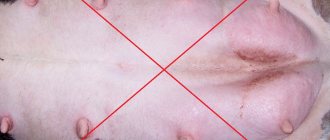The causes of diseases associated with the eyes of a cat can be very different. Each difficult situation is resolved individually. The prescribed course of treatment almost always includes eye drops. These drugs differ in composition, purpose, and contraindications. The instructions for using pharmaceuticals determine the treatment regimen and also explain how to instill the medicine into the eyes of a four-legged pet.
Causes of discharge
There are many reasons for such a deviation.
Anatomically determined lacrimation
In some cases, the cause of tearing is an anatomical predisposition. Discharge and inflammatory processes can occur due to congenital pathology of the animal. This most often affects Sphynx, Persian, British, Scottish and other exotic short-faced cats.
For your information! In a normal state, tears flow into a special nasolacrimal canal, but since the pet’s canal has some disturbances, tears flow into the periocular area.
If the cause of the obstruction is an overgrown or blocked canal, then the problem can be solved by surgical intervention. Unfortunately, surgery is not omnipotent, so there is no guarantee of a positive outcome. In addition, relapses may occur after surgery, so this type of treatment is used very rarely.
If the nasolacrimal duct is obstructed, cats may develop chronic conjunctivitis. To prevent it, it will be enough to carry out daily hygiene care using special lotions. In case of complications, the pet will require periodic antimicrobial and anti-inflammatory therapy.
Allergic reactions
Allergic reactions can occur as a result of animal contact with allergens. Signs of an allergy are frequent sneezing, wet eyes (fluid without pus or other signs of inflammation). This reaction can be triggered by cat food, contact with detergent (typical cat allergens are detergent particles dissolved in the air), medications, a vaccine or a houseplant (allergic reactions to pollen are quite rare). The simplest treatment is to eliminate the cause of the allergy.
Bacterial conjunctivitis
Conjunctivitis is a fairly common eye disease in cats. With conjunctivitis, the conjunctiva becomes inflamed. The conjunctiva is the thin mucous membrane that covers the eyeballs and the inside of the eyelids. It contains the flow channels of the lacrimal glands, which protect the cat's eye from drying out and from small foreign bodies.
Conjunctivitis in cats
Symptoms of conjunctivitis:
- lacrimation and redness of the eyes. The eyelids may swell or experience pain and discomfort when exposed to light. Eyes may change color and become cloudy;
- the movements of the eyeballs are disrupted, and the eyelids become everted.
Note! Catarrhal conjunctivitis is most often observed in cats. This is the most harmless type, which can be treated with standard methods under the supervision of a veterinarian. Characteristic signs are red eyes, swelling of the eyelid mucosa, and an inflamed eye that does not open.
With purulent conjunctivitis in cats, colored fluid begins to ooze from the eyes, and the eye may fester. At the initial stage, yellowish crusts and liquid green-yellow pus can be seen in the eye area. Lack of treatment will lead to serious complications - keratitis, panophthalmitis and blindness.
In the case of follicular conjunctivitis in cats, in addition to the mucous membrane of the eyelids, the lymphatic follicles also become inflamed. The animal will need veterinary care, and treatment may take a long period. Follicles are often removed through surgery, after which a course of treatment is prescribed.
Injury
Eye damage is a very serious problem that can lead to complete loss of vision. Therefore, in case of injury, it is necessary to urgently seek qualified help. Symptoms of eye damage are profuse lacrimation (both with and without particles of pus), unevenness on the cornea, redness of the periocular area.
Eye injuries
Age-related lacrimation (tears in kittens)
A common cause of watery eyes is age-related symptoms. Young kittens (2-8 weeks) and older cats (8 years and older) may suffer from heavy discharge in the eye area. If the secreted liquid is transparent and the animal’s eyes are not inflamed, then hygienic treatment will be sufficient. Watery eyes can also cause decreased immunity. Therefore, it is recommended to take the animal to a veterinarian for examination and determination of the cause.
Foreign object in the eye
If even a small foreign body gets into an animal's eye, serious inflammation can occur, the organ will turn red and increase in size. The fact is that microorganisms located on the surface of an object can cause the development of diseases such as keratitis, uveitis, purulent conjunctivitis, retinal hemorrhage, and also lead to loss of vision.
Important! Sometimes it happens that a particle gets into the eye and initially does not cause discomfort in the cat. But if a foreign object remains in the inner part of the eye for a long time, it provokes various inflammations, including blindness and even the need to remove the eyeball. Therefore, if a cat’s eye is watery and there is a suspicion that a foreign object has gotten into it, you should consult a veterinarian.
Parasites
The cause of the discharge may be parasites in the cat's body. Their presence is checked by analyzing the animal's feces for helminths. If a cat is found to have worms, it is necessary to deworm it.
Conjunctivitis
This is an inflammation of the protective membrane of the eye (conjunctiva). If your cat's eye is red and pus-filled, sticky and watery, he could have contracted conjunctivitis.
There are two types of disease: caused by a bacterial infection and viral. In the first case, the disease develops very quickly, in the second - quite slowly.
It is important to consider that the eyes do not always fester with conjunctivitis. The cat's eye is red. Or both eyes. A colorless mucous liquid flows out of them. And these secretions “slow down” the rapid recognition of the disease. This is a viral form of the disease.
If the pet has contracted bacterial conjunctivitis, then there may be no redness of the eyes. But purulent discharge is a prerequisite for the development of the disease.
How to treat the disease? Firstly, only a veterinarian can make an accurate diagnosis. He will prescribe antibacterial or antiviral medications that are necessary for treatment.
When is a trip to the vet necessary?
When to contact a veterinarian
If both eyes of a cat suddenly begin to get wet, and no inflammation or swelling is observed, then to solve the problem it will be enough to carry out a one-time hygiene procedure. However, if your cat is watering in only one eye, you should see a veterinarian immediately. Only after examining the cat will the veterinarian prescribe tests, after which it will be possible to say exactly what the pet is sick with and how to treat it.
Note! Before going to the veterinarian, it is recommended to rinse your animal's eyes with clean water.
Until the cause of the lacrimation is determined, nothing more should be done.
First aid: how to wash a cat's eyes
If there is no pus, no injuries are found, and the animal behaves quite normally, you can rinse the eyes with tea leaves. To do this, you will need to brew a tea bag, let the liquid cool, and then soak a cotton swab in it. In any case, self-medication can be dangerous if in fact it turns out that the cat had conjunctivitis or keratitis. If left untreated, the animal may lose its vision forever. Take your pet to a specialist who will prescribe therapy or recommend what to wash the cat's eyes with.
Among other things, the reason for the occurrence of such symptoms may lie in the characteristic features of different cat breeds. Sometimes this may be an anatomical feature or a congenital predisposition to certain minor diseases.
How to properly instill eye drops
So, if your pet shows signs of lacrimation, what to do and who to contact is clear. The veterinarian will diagnose the animal’s condition and select the optimal treatment. However, it must be remembered that the effectiveness of treatment of eye diseases will depend not only on correctly selected drugs, but also on their proper use.
How to properly instill eye drops
Doctors often prescribe long courses of treatment rather than one-time drug administration procedures. Correct and careful instillation of eye drops will relieve the animal of stress, which will naturally affect the results of treatment. When buying eye drops at a pharmacy, you should pay attention to the expiration date, otherwise an expired drug will not give the desired effect. The instillation process itself is not that complicated.
- First, you should sit the cat on your lap. The animal should sit with its back to the owner so that neither the tube nor the solution with napkins can be seen. Before using the drug, it is necessary to rinse (with ordinary boiled water) the eyes and the fur around the eye area. Eye treatment should be done with a cloth soaked in water or a cotton pad.
- After clearing the eye of discharge, you need to take the tube with the drug in one hand, and with your free hand, carefully open the pet’s eyelids. Apply the product into the lower eyelid, which is slightly pulled down.
- After the procedure, you need to hold the cat in your hands for a couple of minutes and make sure that it does not start rubbing or squinting its eyes. This sometimes happens because the medicated drops may cause a slight burning or itching sensation.
Traditional methods of treatment
Traditional methods of treatment will help get rid of discharge and alleviate the general condition of the animal, but will not eliminate the main cause of lacrimation. In folk medicine, remedies are used that are similar in composition to tears. They have a moisturizing effect and prevent strong discharge caused by eye irritation.
Important! Some cat owners recommend rinsing the animal's eyes with tea leaves. This should not be done, or you should consult a doctor before the procedure.
Traditional methods of treatment
If your pet experiences occasional seizures for which the cause is unknown, after consultation with your doctor, you can make changes to your pet's diet or include vitamin and mineral supplements. This will support the immune system during inflammation.
Mild chamomile infusions are used as an eye wash. The cooking recipe is as follows:
- Pour dry chamomile raw materials (1 teaspoon) with hot water (250 ml).
- Cover the container with a lid and leave for a quarter of an hour.
- Strain the resulting broth.
- The finished product is used to treat the eyes, soften dried particles of discharge and relieve inflammation.
Note! Before using traditional medicine, it is necessary to establish the reason why the cat’s eye is watering. In case of infection, herbal preparations and moisturizing drops will not be effective, since they do not stop the growth of bacteria.
What not to do on your own
The first thing you shouldn’t do if your cat wakes up with tears in her eyes is sound the alarm. During sleep, discharge from the eyes is typical not only for humans, but also for animals. However, if your pet shows more significant signs of inflammation, for example, the cat has one eye watering, or both eyes have serious inflammation, then it is best not to take independent action, but to take the animal to the veterinarian.
What you shouldn't do on your own
If, before going to the veterinarian, the owner decides to wash out the pet’s eyes, then during the procedure it is strictly forbidden to use a dry swab, much less touch the eyeball with it. If a cat’s eye closes tightly enough, then opening it on your own is not recommended, since you can harm the organ.
What to do if you experience additional symptoms
If the animal constantly experiences discomfort, the cat sneezes and the eyes are watery, it is necessary to examine the pet. To do this, be sure to wash your hands thoroughly, or even better, wear special medical gloves so as not to introduce an even larger infection into the tear duct.
Take a close look and try to determine if there are any swelling around the animal's eye. If you find pus, call a doctor or go to a veterinary clinic immediately, as this may be a sign of a serious infectious disease.
If your cat is sneezing and has a watery eye, it is possible that this is an allergic reaction, which could be caused by poorly sealed chemicals in the house or pollen-rich plants. To test this theory, stop using detergents when cleaning your apartment and try to keep all plants away.
Preventing cat tearfulness
Preventative measures for lacrimation in cats:
- periodic monitoring of eye health;
- regular eye hygiene (if necessary);
- periodic deworming;
- healthy balanced diet;
- periodic vaccination;
- protection against hypothermia;
- timely measures to treat chronic diseases;
- regular veterinarian examinations.
Eye problems in pets occur quite often, so owners of cats and cats simply need to understand, at least at a basic level, how to act in the event of discharge that is not typical for the animal. It is important to identify the disease in a timely manner. Therefore, you should not neglect regular observations of the animal’s health and, if symptoms of lacrimation or inflammation of the eyes occur, seek help from a veterinarian.
How to treat a cat's eyes
First of all, you should carefully monitor the animal’s hygiene, as kittens have problems with this. Therefore, it is necessary to clean your children’s eyes yourself, using a cotton swab dipped in boiled water or a special solution. You can purchase the “Diamond Eyes” product, which needs to be instilled twice a day. Of course, your pet is unlikely to be happy with such procedures, so do not forget to praise him and reward him with all sorts of goodies after each instillation.
If your cat's eyes are watery, this may be the cause of a weak immune system. In this case, it is worth consulting with a veterinarian who will prescribe specialized and natural medications to improve the overall health of the animal.
In order to avoid lacrimation and other infectious diseases, immediately after the kitten appears in the house, you should take it to the clinic and get all the vaccinations. It’s better to be on the safe side than to think later about treating a cat’s eyes or other organs. Also, timely vaccinations will help you get rid of such a common problem as worms. Moreover, some owners mistakenly believe that all they need to do is avoid feeding the animal raw food. Just remember: every time you take your pet out of town, he may eat a mouse or simply meet a sick stray cat.
